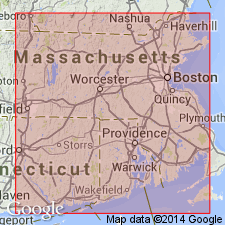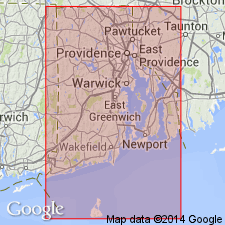
- Usage in publication:
-
- Narragansett Pier Granite
- Modifications:
-
- Revised
- Dominant lithology:
-
- Granite
- AAPG geologic province:
-
- New England province
Summary:
Narragansett Pier Granite and Westerly Granite, which occur in both the Hope Valley and Esmond-Dedham terranes (the Avalon Superterrane of this report) are here assigned to the Narragansett Plutonic Suite (new name). Outcrops trend East-West along the coasts of RI and CT. Similar rocks have also been recognized in southeastern MA. According to Zartman and Hermes (1987), the granites are essentially coeval. The Westerly, though dated at 276+/-7 Ma (U/Pb)), may slightly postdate the Narragansett Pier (U/Pb 273+/-2 Ma) based on apparent intrusive contacts. Narragansett Pier is described as a leucocratic, metaluminous to peraluminous coarse-grained, felsic intrusive. Consists massive pink calc-alkaline granite with biotite, quartz, perthitic microcline and plagioclase. Becomes white near intrusive contact with Narragansett Bay Group [informal name of Skehan and others, 1979.]
Source: GNU records (USGS DDS-6; Reston GNULEX).

- Usage in publication:
-
- Narragansett Pier Granite
- Modifications:
-
- Overview
- AAPG geologic province:
-
- New England province
Summary:
Unit is a 5 km by 40 km batholith that underlies the southern coast of RI. Intrusion during the latter part of Alleghanian deformation of the Narragansett Basin is indicated by its Permian age, rapid cooling, and field relations. The age of the Narragansett Pier is well constrained by several factors. Brown and others (1978) report a Pennsylvanian fossil contained in an inclusion in the pluton. Radiometric ages of 276 Ma by Kocis and others (1978), 272+/-4 Ma by Hermes and others (1981), and 273+/-2 Ma by Zartman and Hermes (1987) are consistently Early Permian. Structural studies by Mosher (1983) and Reck and Mosther (1988) indicate that intrusion began during the third period of deformation in the Narragansett Basin. Argon release patterns (Dallmeyer, 1982) indicate that the granite and intruded sediments had cooled below argon retention temperatures of hornblende by the Late Permian and of biotite by the Early Triassic. Intruded by the Westerly Granite, which has been radiometrically dated at 276+/-7 Ma. The two granites are probably genetically related based on similarities in age, mineralogy, and geochemistry.
Source: GNU records (USGS DDS-6; Reston GNULEX).
For more information, please contact Nancy Stamm, Geologic Names Committee Secretary.
Asterisk (*) indicates published by U.S. Geological Survey authors.
"No current usage" (†) implies that a name has been abandoned or has fallen into disuse. Former usage and, if known, replacement name given in parentheses ( ).
Slash (/) indicates name conflicts with nomenclatural guidelines (CSN, 1933; ACSN, 1961, 1970; NACSN, 1983, 2005, 2021). May be explained within brackets ([ ]).

